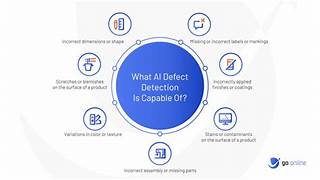AI-Powered Quality Control and Defect Detection: Revolutionizing Manufacturing
In today’s fast-paced manufacturing industry, maintaining product quality is crucial for sustaining competitive advantage and ensuring customer satisfaction. Traditional quality control methods, often reliant on human inspectors and manual processes, can be time-consuming, inconsistent, and prone to error. Enter Artificial Intelligence (AI), a transformative technology that is revolutionizing quality control and defect detection across industries. With its ability to analyze data, identify patterns, and learn from feedback, AI is setting new standards for precision and efficiency.
The Need for AI in Quality Control
As global manufacturing scales up, the volume and complexity of products increase exponentially. Ensuring consistent quality across millions of units is a monumental task, especially when dealing with intricate designs, sensitive materials, or stringent regulatory standards. Traditional quality control methods often struggle to keep pace, leading to potential defects that can result in recalls, financial losses, and reputational damage. AI-powered systems address these challenges by offering:
- Faster Inspection: AI systems analyze thousands of components in seconds, significantly reducing inspection times.
- Higher Accuracy: Machine learning models excel at identifying subtle defects that might be missed by human inspectors.
- Scalability: AI systems can adapt to various production scales, from small batches to mass production.
How AI-Powered Quality Control Works
AI-based quality control systems rely on a combination of advanced technologies, including computer vision, machine learning, and predictive analytics. Here’s how these components work together:
- Data Collection High-resolution cameras, sensors, and scanners capture detailed images or data from the production line. This data serves as the foundation for AI analysis.
- Data Processing and Analysis Machine learning algorithms process the collected data to identify patterns and anomalies. Neural networks are particularly effective for image recognition tasks, enabling the system to detect surface defects, dimensional inaccuracies, or material inconsistencies.
- Feedback Loop AI systems improve over time through continuous learning. As more data is fed into the system, the algorithms become better at identifying defects and reducing false positives or negatives.
- Integration with Production Lines AI systems are integrated into existing production workflows, enabling real-time monitoring and automated responses to quality issues. For example, defective items can be automatically removed from the production line or flagged for further inspection.
Applications of AI in Quality Control
AI-powered quality control is transforming various industries, including automotive, electronics, pharmaceuticals, and consumer goods. Some notable applications include:
- Automotive Manufacturing In the automotive industry, AI systems inspect components such as engines, brakes, and electrical systems. They detect micro-cracks, dimensional deviations, and assembly errors, ensuring that vehicles meet safety and performance standards.
- Electronics Production AI is crucial in inspecting tiny components like microchips and circuit boards. Computer vision systems detect soldering defects, alignment issues, and surface scratches, ensuring high-quality electronics.
- Pharmaceuticals AI systems ensure that pharmaceutical products meet stringent regulatory requirements. For instance, they inspect pill coatings, packaging seals, and liquid clarity in injectable medicines.
- Consumer Goods AI-powered quality control ensures that products like clothing, furniture, and household appliances meet customer expectations. For example, systems can identify fabric tears, stitching irregularities, or paint imperfections.
Benefits of AI-Powered Quality Control
- Improved Accuracy AI systems consistently outperform human inspectors in identifying defects. Their ability to analyze minute details with precision ensures that no flaw goes unnoticed.
- Cost Savings By catching defects early, AI systems prevent costly recalls and rework. Automated inspections also reduce labor costs associated with manual quality control.
- Increased Efficiency Real-time monitoring and defect detection streamline production processes, reducing downtime and accelerating throughput.
- Enhanced Consistency Unlike human inspectors, who may experience fatigue or subjectivity, AI systems maintain consistent performance around the clock.
- Scalability AI systems are highly adaptable and can handle varying production volumes without compromising quality.
- Data-Driven Insights AI systems generate valuable data on production trends and defect patterns, enabling manufacturers to make informed decisions about process improvements.
Challenges and Limitations
While AI-powered quality control offers numerous advantages, it’s not without challenges:
- High Initial Costs Implementing AI systems requires significant investment in hardware, software, and training.
- Complex Integration Integrating AI systems into existing production lines can be technically complex and time-consuming.
- Data Dependency AI systems require large volumes of high-quality data for training. Inconsistent or insufficient data can lead to inaccurate defect detection.
- Limited Expertise Many manufacturers lack in-house expertise to develop, deploy, and maintain AI systems.
- Potential for Over-Reliance Over-reliance on AI may result in complacency, where human oversight is reduced to the detriment of overall quality.
Future Trends in AI-Powered Quality Control
The future of AI in quality control looks promising, with advancements in technology paving the way for even greater efficiency and accuracy. Key trends include:
- Edge Computing AI systems are moving closer to production lines with edge computing, enabling faster data processing and real-time defect detection.
- Augmented Reality (AR) AR tools integrated with AI can provide real-time feedback to human inspectors, enhancing their capabilities.
- AI-Driven Predictive Maintenance AI systems will increasingly predict equipment failures based on quality trends, reducing downtime and maintaining production efficiency.
- Sustainability AI-powered quality control contributes to sustainability by minimizing waste and optimizing resource use.
- Custom AI Solutions Industry-specific AI models tailored to unique quality control requirements will become more prevalent.
Conclusion
AI-powered quality control and defect detection are transforming the manufacturing landscape. By automating inspections, improving accuracy, and reducing costs, AI enables businesses to meet the highest quality standards while staying competitive in an increasingly demanding market. While challenges remain, continued advancements in AI technology promise to overcome these hurdles, paving the way for smarter, more efficient manufacturing processes. As industries continue to adopt AI solutions, the future of quality control will undoubtedly be defined by innovation and precision.


